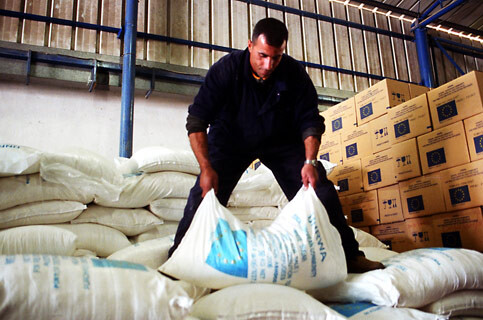The Electronic Intifada 20 February 2009

A UNRWA aid worker in a warehouse. (Shabtai Gold/IRIN)
GAZA CITY, occupied Gaza Strip (IRIN) - Thousands of food-insecure Palestinians in the Gaza Strip are facing an even worse situation after large numbers of livestock and agricultural land were badly damaged or destroyed during Israel’s military assault, which began on 27 December.
The already fragile food situation in Gaza has been seriously aggravated by the conflict, according to a report by the United Nations Food and Agricultural Organization (FAO).
Chicken and meat are now very costly or unavailable, while fresh fruit and vegetables will be unavailable by May due to destroyed crops, according to the World Food Programme (WFP) in Gaza.
An emergency operation was jointly approved by FAO and WFP in January to provide food to 365,000 worst-affected residents in Gaza, including social hardship cases, internally displaced people and farmers to 19 January 2010.
“Part of the emergency operation is being revised in light of the war,” said senior WFP coordinator in Gaza Jeannoel Gentile. “WFP has conducted an emergency food security assessment, and the recommendations will be released this week that will confirm or increase the 365,000 figure.”
WFP’s distribution has started in schools and the general distribution will start this week, said Gentile, although aid continued during the war.
Generally, the UN agency for Palestine refugees (UNRWA) provides food to refugees and WFP to non-refugees, although there has been some overlap since the war.
The emergency operation falls under the recent UN flash appeal for Gaza for US$613 million.
An emergency response to high food prices in the West Bank was also jointly approved by FAO and WFP to assist 31,000 Palestinians with cash-based vouchers worth about $4.17 million (equivalent to about 5,000 tons of food) over 12 months to January 2010.
Poultry losses
“250,000 chickens — about 10 percent of the total production — were killed during the war,” said UN Development Programme (UNDP) agricultural officer Jihad al-Khatib, based in Gaza. “The number of poultry farms destroyed during the war will create a 25 percent deficit in Gaza’s food security.”
“Most of the poultry farms are located in the buffer zone [along the Gaza-Israel border] and were still inaccessible,” said al-Khatib. Some 17 percent of cattle, sheep and goats were also killed.
“My three chicken farms near Netzarim [former settlement where Israeli forces constructed a temporary military base during the war] were destroyed; each farm was 650 square meters with 6,400 chickens,” said Hussein al-Rayes, owner of the Steak House, a chicken distributor in Gaza City.
He estimates to have lost 70 percent of his business since the war, as prices have soared due to a lack of chickens, and because the nearly 70,000 Palestinian Authority employees in Gaza still on the West Bank payroll have not received their salaries.
Before the war 1kg of chicken cost 30 shekels in Gaza, it now costs 48 shekels ($11.60).
“Chicken farming stopped during more than three weeks of war, creating a gap,” said Al-Rayes.
Three of the 11 chicken hatcheries were completely destroyed and two partially destroyed, said UNDP’s al-Khatib, creating a gap in the short run because there is no hatching, reducing the production of livestock.
Meat from cattle and sheep is now hard to find in Gaza City, according to residents, after the main slaughter house serving Gaza City and the surrounding area was bombed.
Some 1,200 ha — 18 percent of Gaza’s total agricultural lands, including orchards of citrus fruits and olives — were destroyed, said al-Khatib, as was 17 percent of vegetable land, including greenhouses, creating a 30 percent gap in Gaza’s food security.
Around 200 ground-water wells were destroyed and 53 partially destroyed, of a total 2,300 water wells serving Gaza’s agricultural lands, said al-Khatib.
Gaza’s agricultural sector grew after the Islamist movement Hamas took control in June 2007 and since the 18-month blockade, most of the production has been sold on the local market.
In 2008 about 14,000 families were considered subsistence farmers, while 60,000 people were agricultural workers, according to UNDP. Agricultural production and fishing comprised nearly 10 percent of Gaza’s economy.
This item comes to you via IRIN, a UN humanitarian news and information service, but may not necessarily reflect the views of the United Nations or its agencies. All IRIN material may be reposted or reprinted free-of-charge; refer to the copyright page for conditions of use. IRIN is a project of the UN Office for the Coordination of Humanitarian Affairs.
Related Links


